-
Posts
2925 -
Joined
-
Days Won
25
Content Type
Profiles
Forums
Events
Posts posted by Rad
-
-
Thanks all. I hope people will go out and climb these lines. I'll admit I'm biased, but people I've taken on tours have said several of these lines are as good as some of the classics at Index. The rock is very high quality and it's a beautiful setting.
Everything you need to know is on one sheet now:
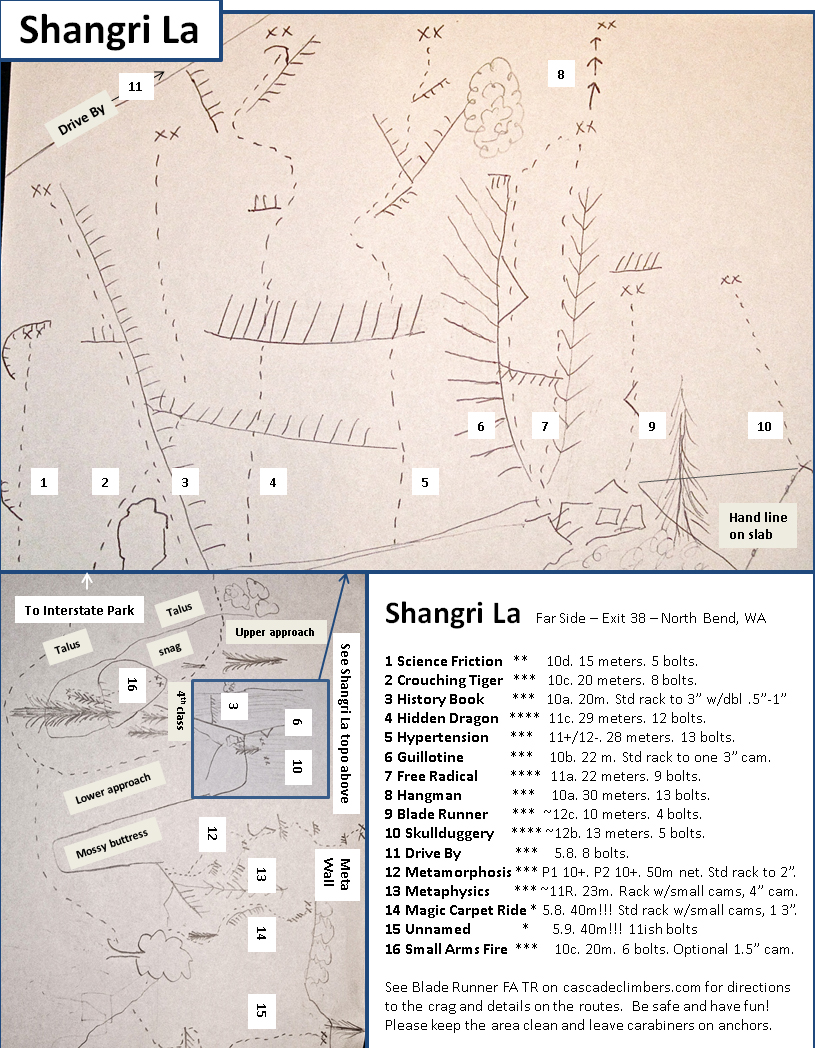
-
Trip: Blade Runner FA + info on 18 new routes at Shangri La, X38
ONE PAGE PRINTABLE TOPO ADDED BELOW.
Date: 10/12/2012
Trip Report:
Blade Runner First Ascent (Shangri La new route info follows).
We like to think that our best days are ahead of us. As climbers, we believe that if we train harder, learn new techniques, and buy the right gear we’ll break through to a new level. This works for a while, but the tides of time are against us. At some point we must pass our high water mark. Most of us won’t recognize this milestone until months or years later, but sometimes you know when it happens. Mine was 8am on October 12th, 2012.
For 15 years I’d been on a 5.9 to 5.10 plateau. There were always excuses. Grad school, post-doc, start-up, kids, remodel. Years of weekend warrior climbing rolled past. The tide finally turned in 2006 when I took a job across the street from the UW climbing gym. I started bouldering regularly and met new partners. Two of them, Alex and Scott, opened up my eyes to the world of new route development. Together, we put up a handful of 5.9 and 5.10 lines in the Deception area of Exit 38. That summer I climbed my first 5.11 in 15 years. 5.11 is barely a warm-up for strong climbers, but for me this was a breakthrough. For almost two decades, 5.11 had been a psychological barrier, an impenetrable ceiling through which I thought I would never pass again.
This made me wonder what my potential really was. At 38, I knew I didn’t have long to find out, so I set a goal to climb my first 5.12 before I turned 40. It was a long shot, but if I tried I might bump up to a new level and be able to climb routes that had long been out of reach. There were obstacles. I was working full time, managing our home remodel, and riding the night train of two small kids with a third on the way, but I did climb. First ascents on the Shangri La cliff at Exit 38 marked a slow but steady rise in my abilities.
2007
Guillotine, 5.10. A gear-protected corner with a sharp flake in the middle.
History Book, 5.10. A gear-protected crack with an ancient piton.
Small Arms Fire, 5.10. A sustained route with small holds on a steep slab.
2008
Metamorphosis, 5.10+. A two-pitch line on a 300 foot face with a mix of bolts and gear.
Crouching Tiger, 5.10+. A route with sloping features and rock as rough as #100 sandpaper.
Forty came and went without a 5.12 redpoint, but I did climb some great 5.11s around the Northwest. The following year, I found three spectacular lines at Shangri La at my limit. To climb them, I had to learn a new process: find solutions for each crux, rehearse the moves, draw a detailed map, visualize the sequences, work to link sections, and then go for the redpoint. This type of mind/body training is not new.
Tony Yaniro was one of the first US climbers to build a training wall that simulated the specific movements he needed for his project. Top climbers of the day scoffed at his approach, calling it cheating, but our bodies are remarkable machines that adapt to the challenges we present to them. If you want to get good at pull-ups you train by doing pull-ups. If you want to get good at certain climbing moves you train by doing those moves. In 1979, Yaniro’s training paid off when he established The Grand Illusion, then the hardest route in North America.
On the mental side, repetition of movements creates muscle memories that allow our bodies to perform complex motor functions. Once these muscle programs, or motor engrams, are mastered they can be played back with minimal conscious input. Watch a toddler try to eat with a spoon for the first time and you’ll appreciate how complex this task really is and how much focus is required to learn new tasks. What enables us to eat our cereal without spilling while walking down stairs and talking on the phone? We’ve mastered each of these tasks through repetition. Interestingly, we can also train for complex movements through visualization, or virtual rehearsal, where we imagine ourselves performing the task. Thus, training your mind actually trains your body, and vice versa.
Achieving mastery of complex motor functions allows us to focus on higher levels of control, such as managing fear, optimizing arousal levels, relaxing unnecessary muscles, and staying focused in stressful situations. Even strength can be traced back to mental training, when we consider that strength training is driven by motivation, discipline, planning, and self-assessment. Free your mind and your body will follow.
I started using these tools and was able to do three 5.11 first ascents:
2009
Free Radical, 5.11-. A striking line on an exposed arête.
Hidden Dragon, 5.11. Four different cruxes spread over a hundred feet.
Hypertension, 5.11+. A hard opening and then several more cruxes.
But I still hadn’t climbed 5.12. The few I'd tried felt impossibly hard. It didn’t help that I was spreading my energies across different sub-disciplines: bouldering indoors, setting routes in the climbing gym, climbing routes outdoors, developing new bolted routes, and climbing in the mountains a few times per year. Time was flying past. If I was going to cross the 5.12 threshold I needed to focus on that goal.
In early 2010, I found my first target: Rainy Day Women at Little Si. It suited my style, with three bouldery sections separated by good rests. I found solutions that worked for me, drew a detailed map, rehearsed, and tailored my training to the three cruxes. On March 14th everything came together. The final crux, which had felt desperate on previous attempts, went smoothly and I made the redpoint.
I was elated, but RDW is known to be soft for the grade, so I looked for my next target. I’d heard Lay of the Land was good, so we gave it a try. As before, I made a plan, drew my map, visualized the sequence, and trained for the crux. I planned to skip a bolt near the end that was difficult to clip and created rope drag. The second trip out I made it to the anchor but missed a key foothold and fell trying to clip the chains. I added that foothold to my mental map and sent the route on our next trip. The satisfaction of climbing a route is usually immediate and fleeting, but this was deeper and grew over time. One route might be a fluke, but not two. I’d started across the elusive 5.12 threshold.
Two months later, I bolted a spectacular line at Shangri La that I knew would be in the 5.12 range: Skullduggery. It was continuously overhanging, sustained, and technical. New routes are particularly enticing for me because they represent unsolved puzzles on unexplored terrain. Maybe a few will become classics that people will climb for decades to come. Skullduggery had all the right ingredients, but I couldn’t link the moves.
Psychology shows that motivation is highest when the chance of success is around 40% to 60%. Above 80%, we assume we’ll succeed and don’t bother preparing. Below 20%, we probably don’t think it’s worth the time and effort to try hard. But it’s not that simple. Creativity, visualization, rehearsal, and route-specific training can dramatically increase the odds of success on a route. Finding a solution to the crux that matches your skills and strength might increase the overall odds of success from 2% to 20%. Rehearsing sequences makes you more efficient and gives you more energy for the final cruxes, perhaps increasing the overall success rate from 20% to 60%. But you have to choose the right objectives.
Skullduggery was a perfect goal for me in 2010 because it represented a possible first ascent just beyond my limit. I drew a map that detailed 68 hand and foot movements, rehearsed the moves, and trained for specific movements. Being strong enough to do the moves doesn’t guarantee success. The proper mental state is also essential. I needed to be calm but psyched to give 100%, energized but relaxed, and, perhaps most importantly, focused on the process and not on the outcome. Zen.
On a cool summer morning in July of 2010, after two weeks of rehearsing and training on a fixed line, I went up with Jens to go for the first ascent of Skullduggery. Fortunately, that morning I was in the zone, that rare space where mind and body perform seamlessly as one. It was almost as if I was a detached observer watching a carefully choreographed gymnastics routine. I sent the route first go. Oddly, it was both anti-climactic and deeply satisfying. Skullduggery was the hardest route I’d ever climbed and is definitely harder than the four other 5.12a routes I climbed in 2010. As far as I know it hasn’t been repeated.
Fifty feet left of Skullduggery is a clean overhanging face whose crux involves improbable moves on a protruding blade of rock. This feature inspired the route’s name: Blade Runner. The day I climbed Skullduggery, Jens and I tried Blade Runner. We could do the opening moves but were completely shut down by the crux. There were features, but we couldn’t work out how to use them.
My brain wrestled with this puzzle on and off over two years. I would envision a solution, get excited, and go try it. Each time, I was shut down and went home thinking I would never climb the route. But I kept turning the puzzle over and over in my mind. In the summer of 2012, I made a close inspection of all of the features on the route and started working in earnest to find a solution.
Idea #1: Grab two sloping holds and do a huge dynamic leap to an undercling and sloper that must be caught simultaneously. Fail. The slopers aren’t as positive as they look, the footholds are crappy, and the catch holds are too far away.
Idea #2: Lie back up the left side of the blade. Fail. This is very strenuous, and the blade ends well below the next set of holds.
Idea #3: Knee bar up the cleft left of the blade. Fail. The wall where you place your feet slopes away so this is challenging, and the knee bars end where the blade ends, well below the next set of holds.
I wasn’t making any progress. Truth be told, there were times I was tempted to chip a hold. A tiny foot chip on the blade, or an incut in the arch, might allow me to get past the crux. I have a chisel and hammer. No one would know. But I would. And I would be bringing the route down to my level instead of meeting the challenge presented by nature. So I refrained, as I always have, even if it meant I would never climb the route. Instead, I started to break the problem down into smaller puzzles.
Idea #4 and Solution Part 1: I figured out I needed to lie back on a vertical sidepull above the blade to reach the next set of holds. Getting to the vertical sidepull became the new crux. I tried to get my left foot up onto a high hold to set up the lie back. Fail. I can’t get my foot that high without falling because the handholds aren’t in the right positions.
Idea #5 and Solution Part 2: I figured out I could get a heel/toe cam on the flat wall of the blade and use this in opposition with the sloping rail to move up to the vertical sidepull in a compression sequence. The new crux became the transition between the compression sequence and the vertical sidepull. Fail. If you compress too hard you fly off when you try to bump your hand up to the vertical sidepull. But this can be fixed.
Idea #6 and Solution Part 3: I needed to work out how to move into and through the compression moves, maintaining high body tension, without pushing myself off when I made the bump to the vertical sidepull over my head. Small adjustments to foot, hand, and body positions, as well as force angles and force magnitudes, were going to be critical. After many hours on the rock I found an optimal combination and could just barely make the compression to sidepull transition. I’d solved the hardest part of the crux but still needed to move over to the next holds out left.
Idea #7 and Solution Part 4: Maintain tension and pinch the blade between my feet to push out left to a crimp. This feels strange, but it works.
The opening moves needed to be more efficient so I would have enough energy for the crux and the hard moves beyond it. The section after the crux would provide unexpected challenges and an amazing sequence as well, and, of course, I would need to link it all together, but I was zeroing in on my solution. I wrote a map that detailed 75 precise hand and foot movements from start to finish. After each work session I updated this choreography. Now I needed to link the sequences together, figure out where and how to clip the bolts, and train my mind and body to perform the route. To prepare for Blade Runner’s crux, I trained to compress two sloping sidepulls while maintaining high core tension and balancing on my right tiptoe. From this position, I had to bump my right hand to the vertical sidepull over my head. What had once seemed impossible was beginning to loom on the horizon as something I might just pull off.
But time was running out. It was October. We’d had the longest continuous run of good weather in a decade, but the winter rains were on the way. I trained for the specific movements I needed for the route, rehearsed and refined my solution for the crux, worked out the most efficient path for sequences before and after the crux, and started to put it all together.
When mind and body are primed for peak performance there is a window of opportunity to break through to a new level. I had entered that window for Blade Runner, but it wouldn’t be open for long. On October 6th, I went out with Ed to try to climb the route. Unfortunately, I had a cold and was on pseudoephedrine.
Attempt #1: I moved smoothly through the opening but fell at the crux due to lack of body tension.
I rested, but the pseudofed wouldn’t allow my heart rate to return to baseline.
Attempt #2: I got through the crux but fell on one of the last hard moves after burning too much energy clipping the last bolt.
Attempt #3: I made it through the crux but fell below my previous high point.
Attempt #4: I fell at the crux, too spent to maintain enough body tension to make the bump to the vertical sidepull.
I needed a little more strength, a better foot sequence after the crux, and a better strategy for clipping or skipping the last bolt.
We went home. I rested on Sunday, did movement-specific training on Monday, refined my foot sequence, and planned to skip the last bolt. I felt ready, but the Fates were about to intervene.
The long-range forecast showed a wall of rain coming on Friday, October 12th that would shut us down for the season. Several partners said they could go out on Saturday the 13th, but that would probably be too late. My window was about to slam shut. I was 44 and had three growing kids, a growing list of minor injuries, and a job that was growing more fun and more demanding. There was no guarantee I’d be strong enough, healthy enough, or have enough time to climb Blade Runner in 2013, or perhaps ever.
I made two back-up plans. The first was duct tape. Blade Runner is steep enough that only three of its holds get wet after a light rain. I dangled from the rope and fashioned duct tape tents and drain systems for these holds in case I had to make an attempt on Saturday in the drizzle.
The second plan was to call Jens and ask if he would go on a Friday dawn patrol mission. Thankfully, he knew how much I wanted this and was willing to give it a shot despite a mediocre forecast that showed rain starting around 10am. We planned to leave my house at 6am. My wife would take the kids to school.
Thursday evening I ate a hearty meal, got the kids to bed, packed the gear, took a hot bath to relax the body and mind, and went to bed early. Then my wife’s pager went off. A patient in Bellingham needed emergency surgery. If the patient came down Friday morning I’d need to take the kids to school and we wouldn’t get to the crag until at least 10. By then it would probably be raining. Kids and patients come before climbing, of course, but it felt like the Fates were taunting me. The patient came to Seattle at 11pm, and my wife did surgery until 1am, so I was free to go at 6am as planned, assuming there were no more emergency calls. There weren’t.
I woke at 5:20am. It was pitch dark, but I saw water running down the window and heard rain gently pattering on the roof. Everything was wet. I looked at the forecast for North Bend. 70% chance of rain for 7am and 8am, 30% for the rest of the morning, then 60% for the rest of the day. The window had slammed shut. Should I text Jens and tell him to stay in bed? I’ve worked too hard to give up now, and he was probably already on the way over. Let’s just go take a look.
Jens arrived at 6am and we drove East through the rain. There was no wind. The wall of rain was marching slowly and steadily East toward Blade Runner. Was the crag wet? Would the duct tape keep the holds dry? There was no way to know until we got there. Amazingly, we emerged from the leading edge of the advancing rain when we reached North Bend. I turned the windshield wipers off. The highway was dry. We got to the trailhead just before 7am. Everything was still dry. Either the sky was about to open up or the forecast I’d seen was wrong. We would soon find out.
We hiked up to the Shangri-La cliff. Temps were cool. The rock was dry. All was calm. We didn’t know how much time we’d have before the wall of rain was upon us, but I needed a warm-up so we quickly climbed Crouching Tiger. Then it was time for Blade Runner. I knew I wouldn’t have enough strength for a lot of attempts, and the rain could start falling any minute, but I stayed calm. I was ready. I’d climbed the route many times in my head. It was time to climb it in real life.
I tied into the rope, put my shoes on, climbed up to clip the first bolt, and then climbed back down again.
I closed my eyes and breathed slowly in and out, in and out, to get my heart rate down.
After a few minutes, I opened my eyes and cast off: crossover from the undercling into the first lieback, twist my left leg as I move into the second undercling (the opening flowed smoothly) clip the bolt at the crux, set my heel-toe cam on the blade, move smoothly into the compression sequence, tense the core, bump to the vertical sidepull (my mind was empty but focused) pinch my feet on the blade, press to reach the small crimp out left (I was now through the crux but had fallen past here before) keep weight on small footholds, skip the last bolt, deadpoint to a good hold (just a few more hard moves) reach left to the pinch, pop to the undercling (almost done now - breathe) cross through with the feet, balance on two slopers, lock a heel hook down, and move to the final sloping sidepull...Clip. Clip. It was done. The impossible dream had been realized.
It was 8am on October 12th, 2012. I’d reached my high water mark.
Jens tried the route, and then we removed the quick draws and pulled the rope. By the time we reached the car the rain had started. It wouldn’t stop for over a month, and the whole cliff would be soaked until spring.
Blade Runner was one of the most rewarding experiences in my 22 years of climbing not because it was the hardest route I’ve ever climbed, but because it required a huge mental and physical investment that pushed me beyond my perceived limits.
I’ll probably never climb a harder route. I’m OK with that. But twenty feet right of Blade Runner is an even steeper, more intimidating line that looks amazing. I’m sure it’s way too hard for me, but maybe I’ll just go take a look...
…………………….
Shangri La
Details on 18 new routes in the Shangri La area of X38
-Please pack out all trash. Obvious pathways away from the crag are on the lower approach so please don't soil them with human waste. Please leave carabiners on anchors for lowering a la Nason ridge. Enjoy!
…………………………
Most of these routes get good sun exposure and dry fast. The start of History Book and one section of Guillotine are prone to seepage after a lot of rain, but most other routes dry quickly. Blade Runner and Skullduggery face South and are best climbed in the early morning or on a cloudy day. Metamorphosis faces East and can be hot on a summer morning.
Route distribution*:
5.8 3
5.9 1
5.10 7
5.11 5
5.12 2
* - Ratings are subjective. Proposed ratings are suggestions based on how the routes might compare to similar routes at the Lower Town wall at Index. I will enter these on Mountain Project. Feel free to suggest your own ratings so we can arrive at a consensus.
……………………………………..
Printable topo

Approach notes:
Orientation: The Far Side area of X38 has several East-facing crags in a line: Interstate Park, Eastern Block, Squishy Bell, and Headlight Point crags. Ellie's Sweet Kiss is a very popular route in the middle of Interstate Park. Shangri-La is on the Eastern and Southern faces of the large rock formation across the giant talus field East of these crags.
A few Far Side maps:
Roads and topo for X38 Far Side
The trails map is not to scale. Winter Block is almost directly above Shangri La.
Hiking directions:
Go to the Far Side parking lot. Start up the trail that starts just N of the bridge over the SnoQ river. When the trail forks go left, then an immediate right/straight, cross a wet area on a tiny boardwalk, then go left. Gritscone is in front of you at this point. Follow the wide trail, avoiding turnoffs to the right. When the trail steepens turn left into the forest at a small saddle. Follow the trail up steeply to the where it flattens out. Turn right on one of the side trails and make your way to the line of cliffs that includes Interstate Park, Eastern Block, Squishy Bell, and Headlight Point. Shangri La is East of the obvious talus field East of these cliffs. There are two ways to approach Shangri-La from the talus field:
1 - Aim for an obvious dead snag on the buttress that is about the same level as Ellie's Sweet Kiss. To get there, follow a series of easy but exposed ledges that start below some brush on the E edge of the talus. Pass below a large pine and head to the dead snag. From the snag, scramble down about 25ft of 4th class to the East. This brings you to the base of the wall. The first obvious feature is History Book, a left-leaning dihedral. You may notice some chains at the top of the face near the dead snag. This is the anchor on Small Arms Fire, which is a rap in and climb out route.
2 - Follow the talus down to the bottom of the buttress, cross under the bottom of the buttress on a faint trail that passes a giant tree with a cable on it. When you get to a smaller talus field, go straight up hill. When the talus ends at the forest go straight up to the base of the Shangri-La crag with History Book and Guillotine and Skullduggery. You'll know you're in the right place when you see a giant corner with a huge flake about 40 feet up (Guillotine), and several bolted lines. To get to Metamorphosis and Magic Carpet Ride, go right at the top of the little talus field mentioned above.
View of the talus and upper and lower approaches from the top of Ellie's Sweet Kiss.
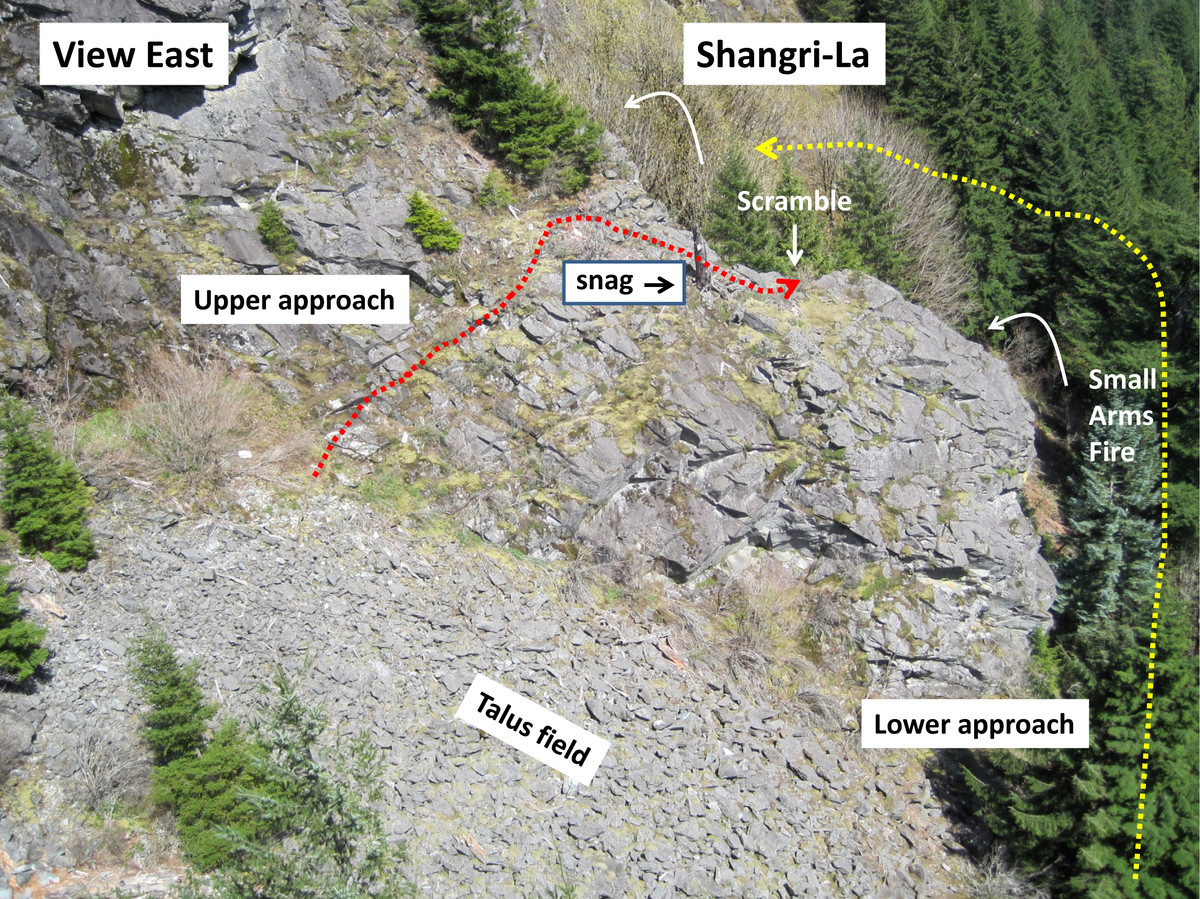
Looking back past Shangri-La with Ellie's Sweet Kiss in the background.
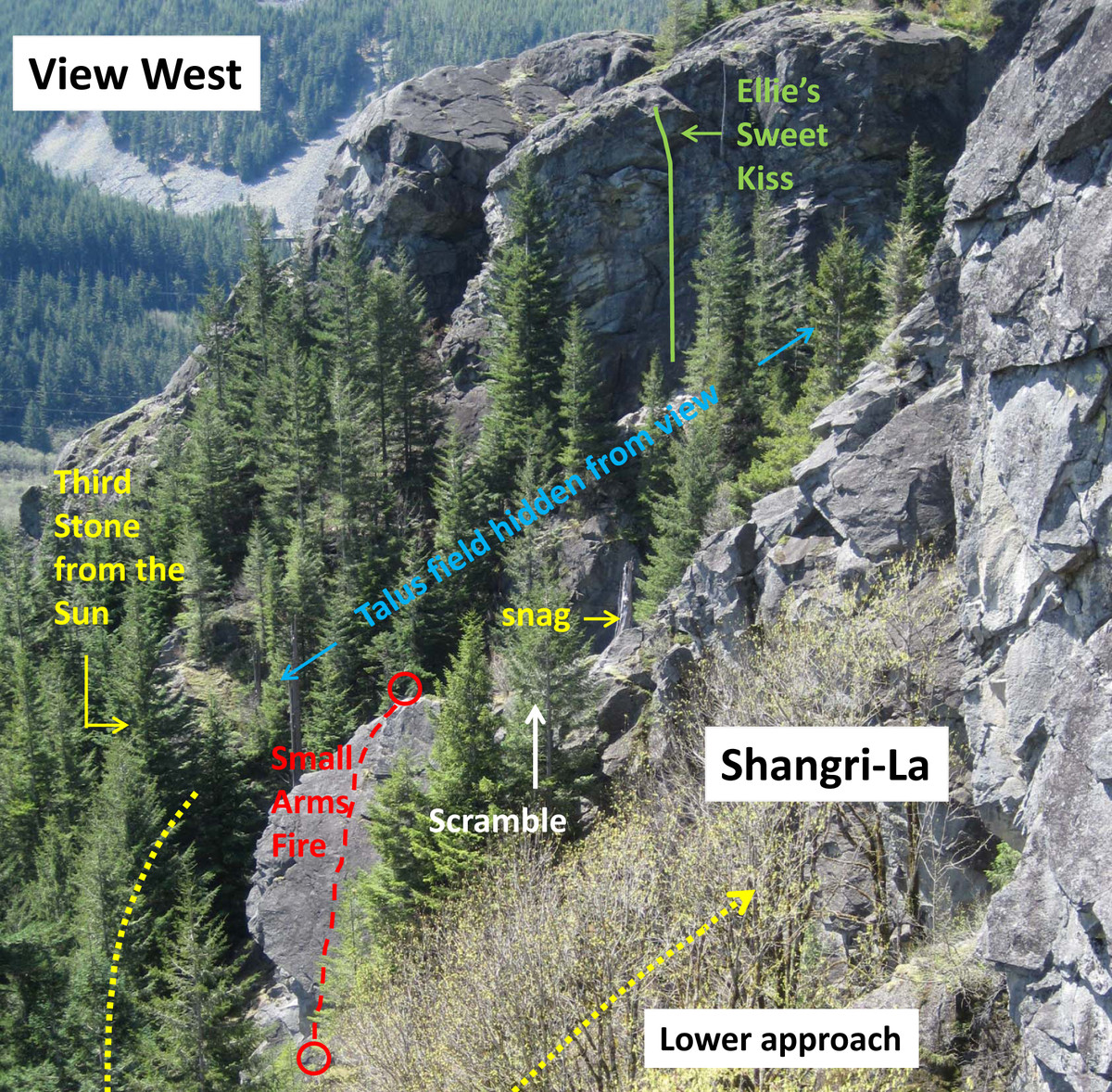
Looking up at the 4th class scramble. It's easier than it looks.
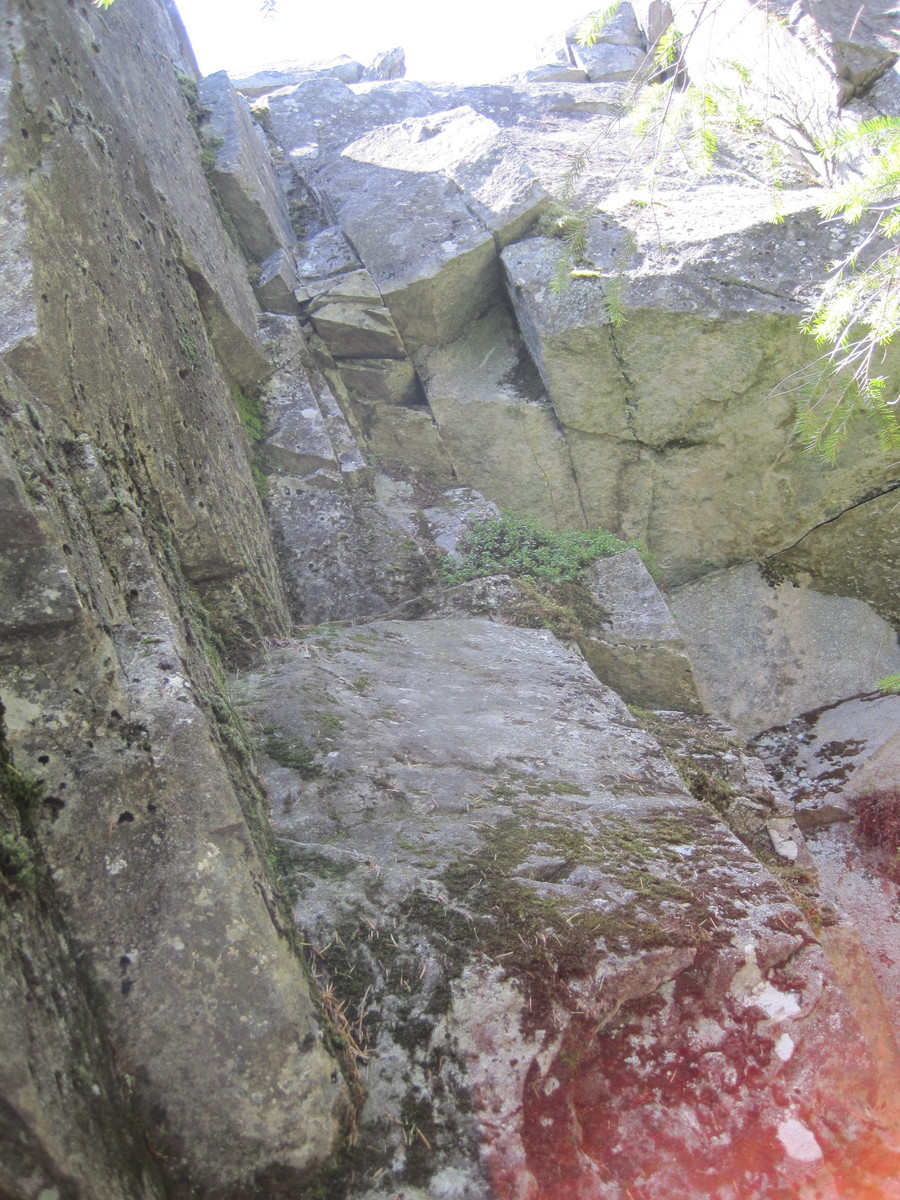
………………………………………
The following routes are on a wall on the left side of the guillotine corner. From left to right:
Science Friction = 5.10d bolted face with two friction cruxes. Left of History Book.
5 bolts. 15 meters. FA Roberts, August, 2012.
History Book = 5.10a trad crack in a left-leaning dihedral. Follow the crack to chains at the top of the cliff.
DO NOT trust the ancient rusty aid piton!
A standard rack will suffice. 20 meters. FA (ground-up onsight) Roberts, August, 2007.
Crouching Tiger = 5.10c bolted roof and face climbing.
Start 10 feet left of History Book, head up and right to the first bolt, and then go straight up over a series of small roofs.
8 bolts. 20 meters. FA Roberts, October, 2008.
Hidden Dragon = 5.11c (11+ if shorter than 5’9”) bolted face and roofs. Start 8 feet right of History Book.
This route has four different cruxes, multiple roofs, and a clean upper dihedral.
12 bolts. 29 meters. FA Roberts, July, 2009.
Hypertension = 5.11+/12- bolted face and roofs. A stick clip might be wise as the bouldery crux is off the ground.
Requiring power, balance, and body tension, this route will test your versatility.
13 bolts. 28 meters. FA Roberts, September, 2009.
Guillotine = 5.10b trad crack and flake in a giant corner.
Enter the corner near the first bolt of Free Radical (a solid cam can be placed at the lip if you’re a purist).
Climb up to and past the namesake flake on the right wall and follow the corner to its end.
Then clip a fixed nut and make some airy moves up and right to the chains.
A standard rack is fine. 22 meters. FA Roberts, August, 2007.
Free Radical = 5.11a bolted route on the arête right of Guillotine.
Outstanding moves in a great position. Shares an anchor with Guillotine.
9 bolts. 22 meters. FA Roberts, August, 2009.
Hangman = 5.10a bolted face and roof with fun friction moves at the top.
This starts at the Guillotine/Free Radical anchor and goes a full 30m to chains.
You can link Free Radical and Hangman for a 52 meter pitch. You'll need about 23 quickdraws to get up and a 60m rope to get down.
13 bolts. 30 meters. FA Roberts, June, 2007.
The following routes are on the overhanging face right of Guillotine:
Bladerunner = 5.12c? (5.11 to V6 to 5.11) overhanging bolted face on pristine rock. Unrepeated.
This route takes a striking line up the super-clean, overhanging face right of Free Radical. It has a devious crux that requires core strength and creativity.
Easy to top rope after climbing Guillotine or Free Radical, but be sure to use the Bladerunner anchor as there is a sharp roof above that could damage the rope if you TR from the Guillotine/Free Radical anchor.
Overhanging, South-facing exposure keeps this route dry most of the year.
4 bolts. 10 meters. FA Roberts, October, 2012.
Skullduggery= 5.12b? Unrepeated.
A bit of skullduggery (an act of trickery or deception) may be needed to get up this steep, technical, and sustained line
Overhangs 17 feet in its 40 foot length. Starts fifty feet right of Free Radical. A worthy test piece.
Use the hand line to ascend the slab. Belay/start at the bolt and fixed cam that anchor the hand line.
5 bolts. 13 meters. FA Roberts, July, 2010.
Open Project = 5.12+ or harder route on an overhanging face right of Skullduggery. Bolted.
The following routes are on walls around to the right from Shangri-La.
To get there, descend a trail about 100 feet and then veer left into the next amphitheater.
Three routes are ready for climbers:
Meta Cliff:
Metamorphosis = 5.10d adventurous two pitch line up the center of a 300ft face.
If you stand at the giant tree, look up and left at a big face. Metamorphosis p1 (10+) climbs up the center of this. The first pitch starts at a small roof at the ground, gear goes in a small crack, two bolts lead past a bulge, gear protects moves up higher, and there is one final bolt before the belay just below a large ledge (5.10+). The second pitch starts up a flake and vertical crack, moves up and left and then back right past bolts and gear, follows three bolts up thin and exposed face climbing, passes a short crack before a ledge, and ends with a bouldery finish past a bolt (5.10+). You could continue up 4th class terrain to a bolted anchor at an airy perch atop the Shangri-La cliff. Rap with one or two 60m ropes. Ropedrag might be bad if you try to link the two pitches. Note: it is best to belay for the first pitch very low at a divot in the vegetation.
Start climbing in tennis shoes and change to rock shoes at the small roof. Needs an approach trail.
Gear from small cams to #2 camalot. 50 meters total. FA Roberts, May, 2008.
Metaphysics = 5.11R? (5.10R to a well-protected V3 crux at the roof to a 5.10 upper section). Unrepeated.
This trad line follows the start of Metamorphosis to the flake below the first bolt. Place cams in a diagonal crack on the face 6ft below this flake and then traverse straight right 6 feet. Follow holds straight up and over the obvious roof. There is good protection in cracks on the slanting roof section. Climb up to the second roof, place gear, and zag up and left to the anchor at the top of the first pitch of Metamorphosis.
Microcams to a single #4 camalot for the last placement. FA Roberts, November, 2011.
Magic Carpet Ride = 5.8ish trad crack up a series of corners.
This is on the large slabby face about a hundred feet right of Metamorphosis. Head up to a large tree. Pass this and continue up to the higher of two left-traversing cracks.
Follow a series of corner cracks/dihedrals to the top of the buttress. You’ll see the scrub line. Turn the last roof on the right and follow a mossy ramp to anchors up and left. This route is about 40 meters and will get better with more traffic. You can rappel with two ropes, just barely get down with a single 70 meter rope, or rap to the tree with a single 60 and rap again or down climb.
Standard rack. 40 meters. FA Roberts, April, 2008.
Unnamed = 5.9ish bolted line. This starts about fifty feet right of Magic Carpet Ride. Follow a scrub line up and right toward a small roof and a bolt. Follow a line of bolts up nice but slightly dirty climbing. Bolts are in a line but some zigzagging is needed to climb past the roof. It’s about 35m to the anchors so bring two ropes. Nice moves all the way to the end.
10 bolts? FA Krawarik, 2009.
The following climb is on a face above the giant tree below the buttress with the dead snag. This can be approached by rapping in from chains at the top of the buttress next to the dead snag. Direct approach from the bottom may be developed.
The following climb starts at the base of a large pine just uphill from the dead snag.
Drive By = 5.8 bolted arête and face in a great position with excellent views.
Clip one chain, skip the next chains. Put a long runner on a bolt 15 or so feet higher, and then aim for the slab/arête feature above you. There are several bolts on the slab leading to a final mantle. Rap the route. Be careful not to drop things on parties below.
25 meters. 8 bolts. FA Roberts, Krawarik, Anderson, May, 2007.
Unnamed = 5.8 trad corner above Drive By that needs some gardening but is still fun. 27 meters?
Standard rack. FA Krawarik, Locke, June, 2007.
The following climb is on a face above the giant tree below the buttress with the dead snag.
This can be approached by rapping in from chains at the top of the buttress next to the dead snag.
Small Arms Fire = 5.10c bolted face with thin, balancy moves in a great position.
Rap down to the starting anchor from chains near the dead snag. Lead out or do a top belay.
6 bolts. 20 meters. FA Roberts, August, 2007.
The following route is quite close to Headlight Point, on the way to the lower approach to Shangri-La.
Approach: Headlight Point is the first cliff you get to when coming from the Gunshow area. It is the Southern-most crag of easy (5.6ish) climbs on the trail. Right behind those climbs, is a tree and a dirt ramp that leads a few meters down into the forest. Follow the ramp a few feet. Skirt a bush, drop a few feet along a tiny talus field, and head across to the obvious cliff. A large flat rock at the base of a tree marks the start of Third Stone from the Sun. To continue to Shangri La, follow the small cliff to its end at the giant talus field. Cross that and head for the approach that goes below the bottom of the large buttress as described above.
Third Stone from the Sun = 5.11c bolted overhanging face.
Lots of action in a small package.
5 bolts. 11 meters. FA Roberts, June, 2011.
Photos:
History Book
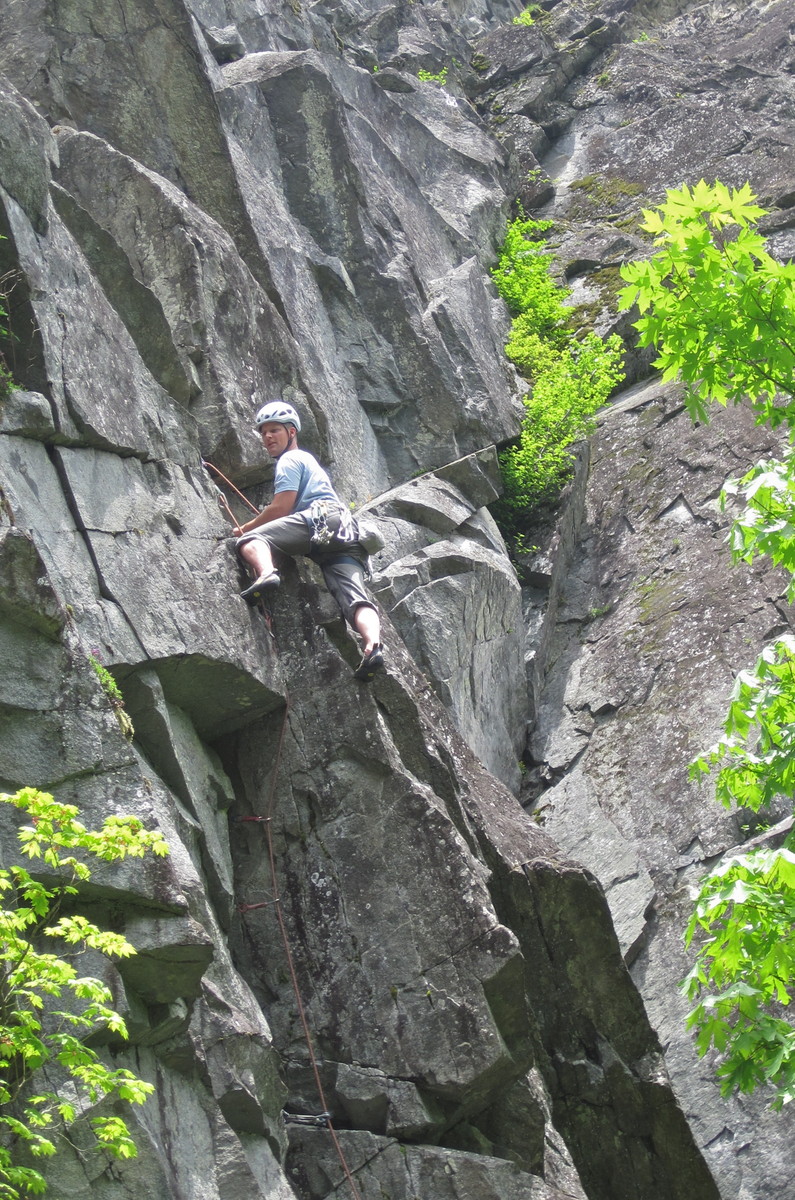
Crouching Tiger low
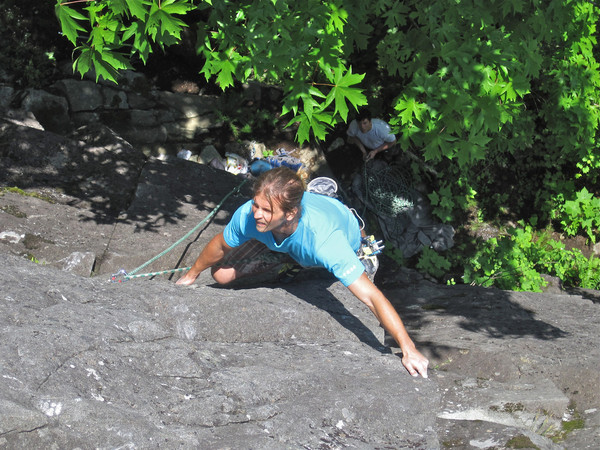
Crouching Tiger middle
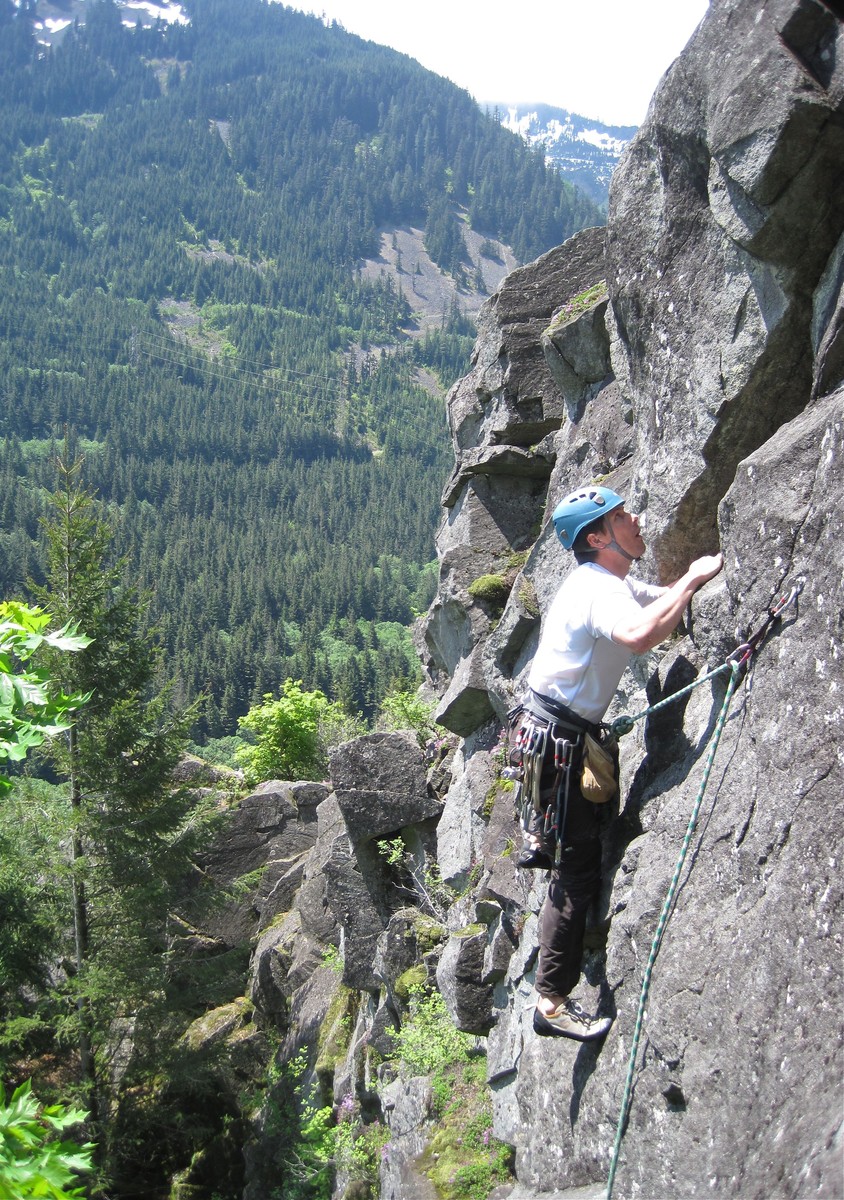
Crouching Tiger high - McClellan Butte in the background.
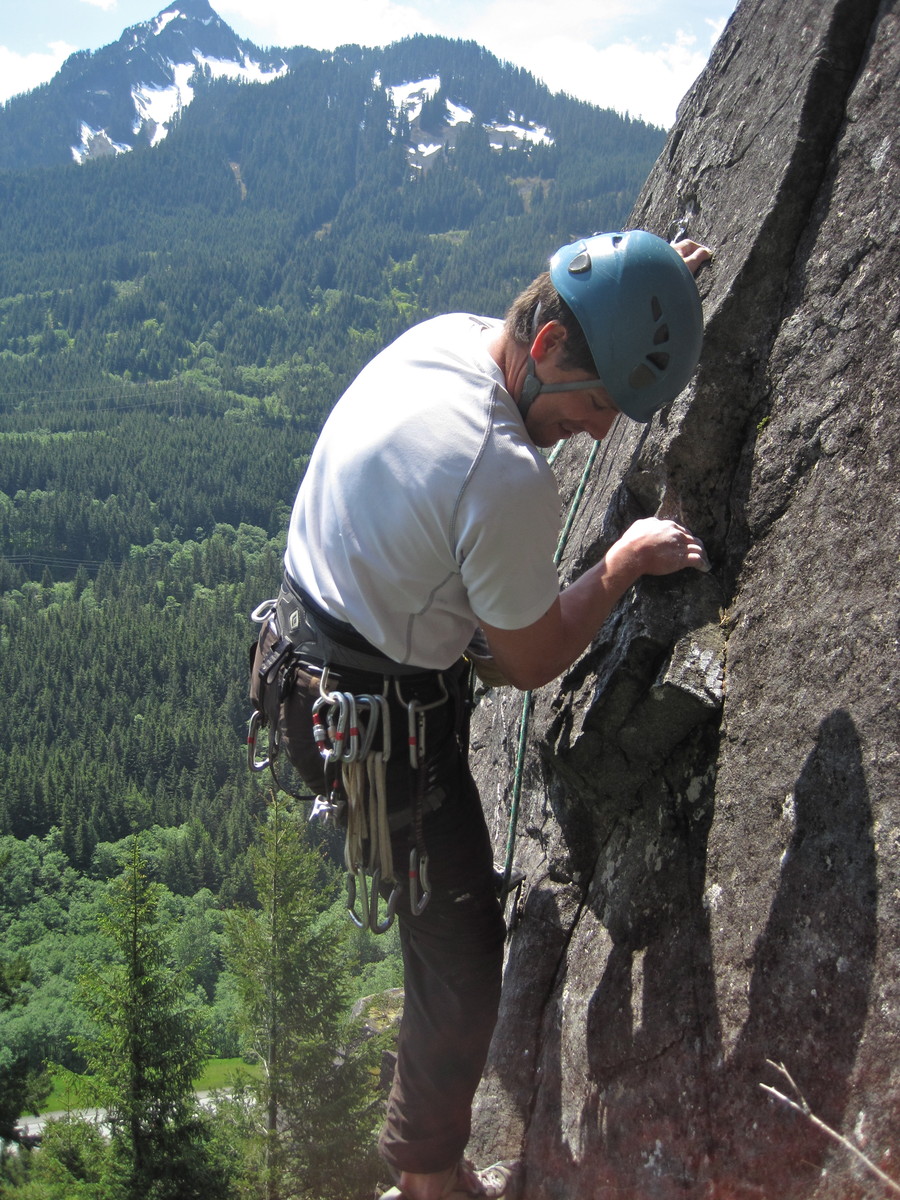
Hidden Dragon
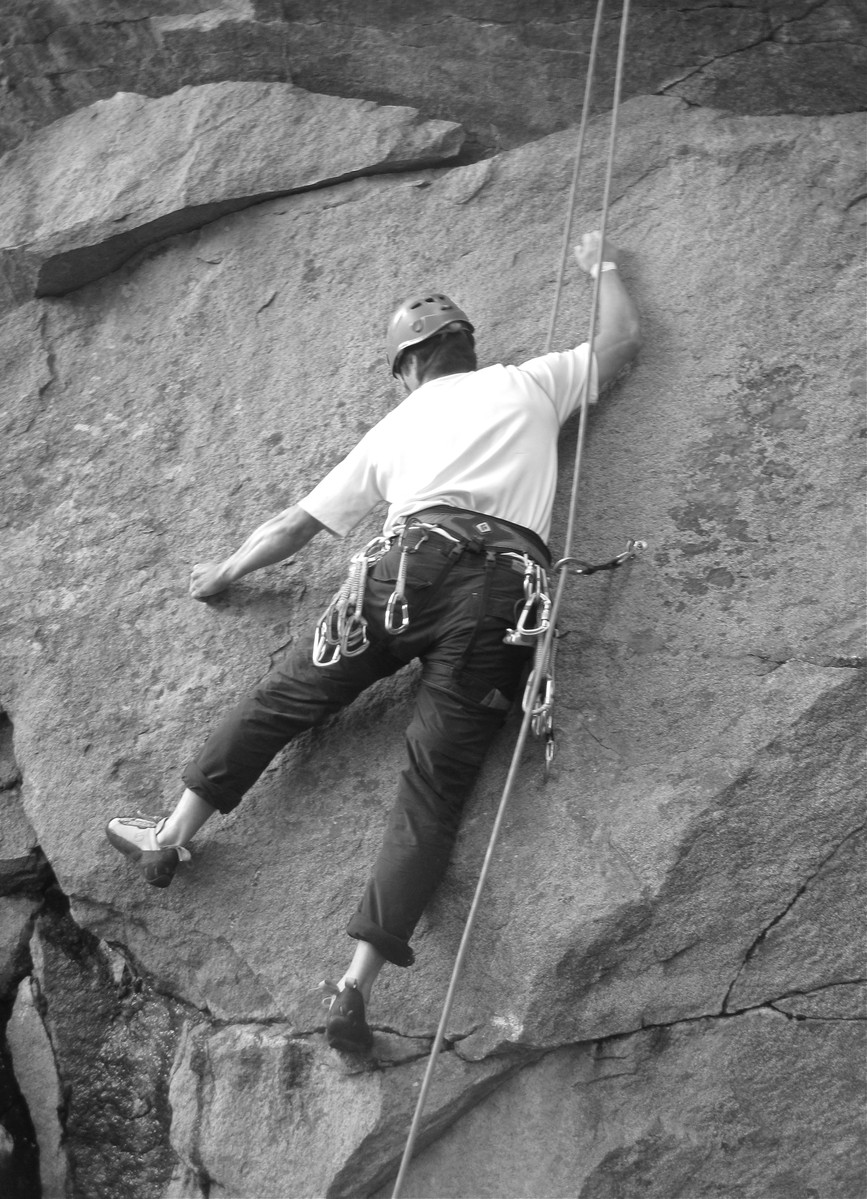
Red line is Hidden Dragon. Green is Hypertension. Both continue out of sight above.
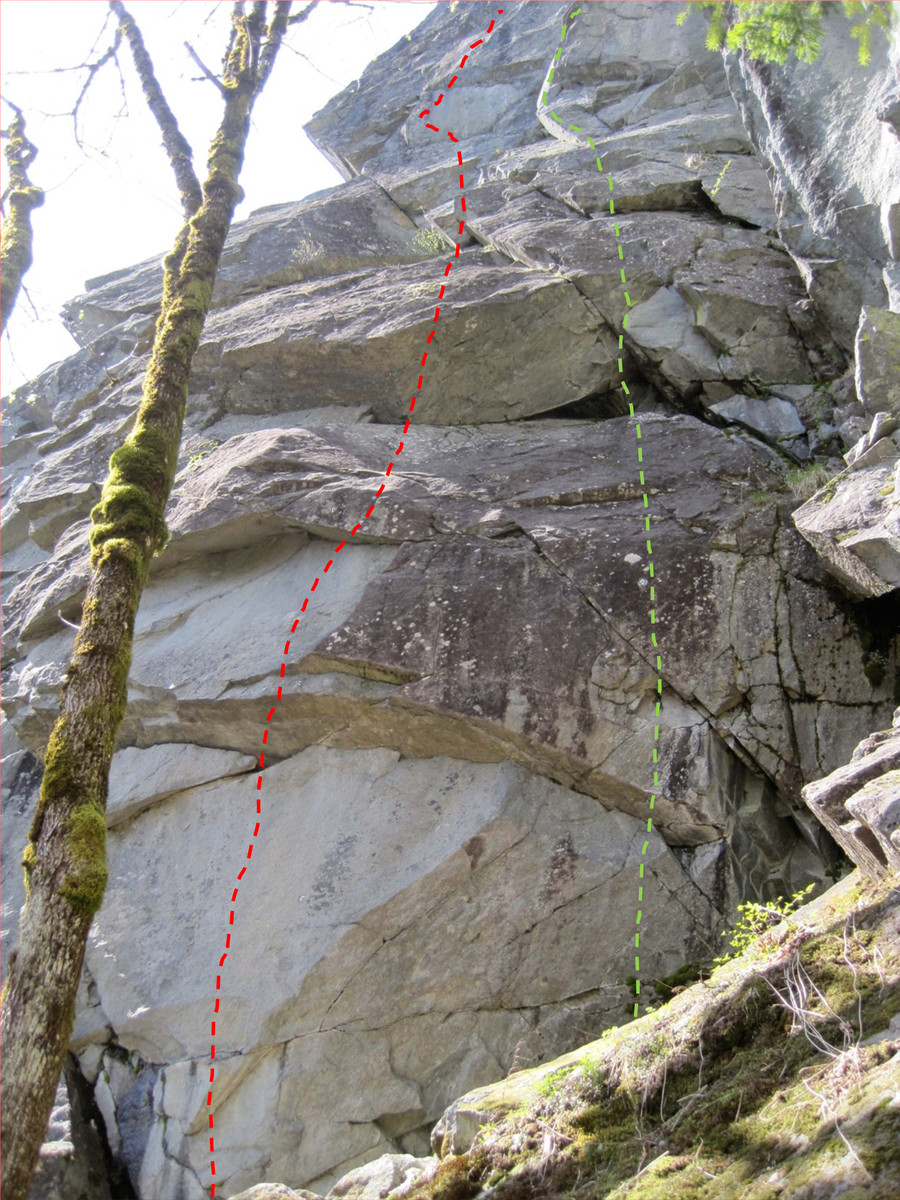
Guillotine
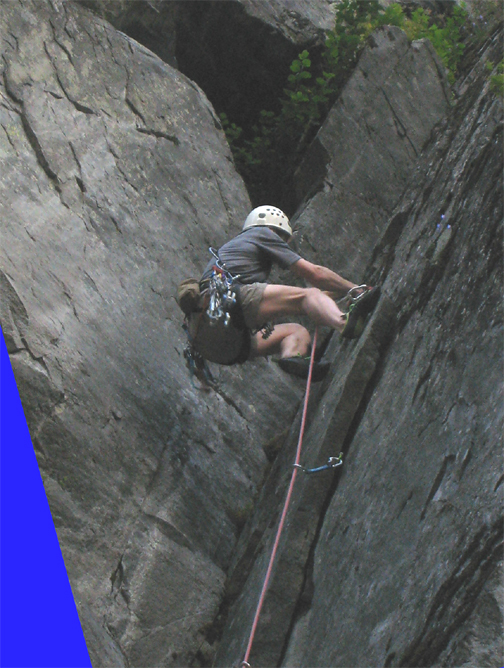
Free Radical is the arete right of Guillotine, which Ian is climbing here.
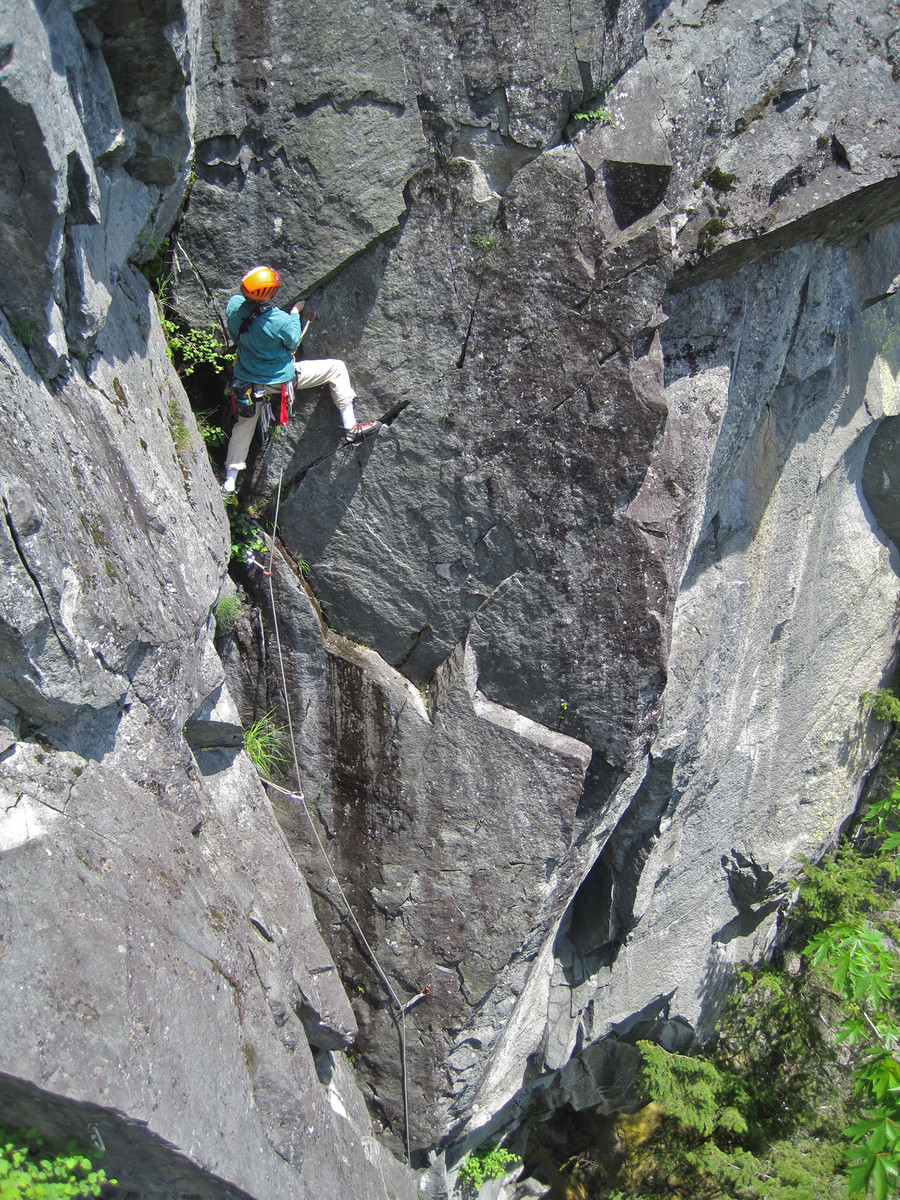
The Guillotine flake is visible on the left. Free Radical is the arete left center. Blade Runner is right center and ends at the visible chains.
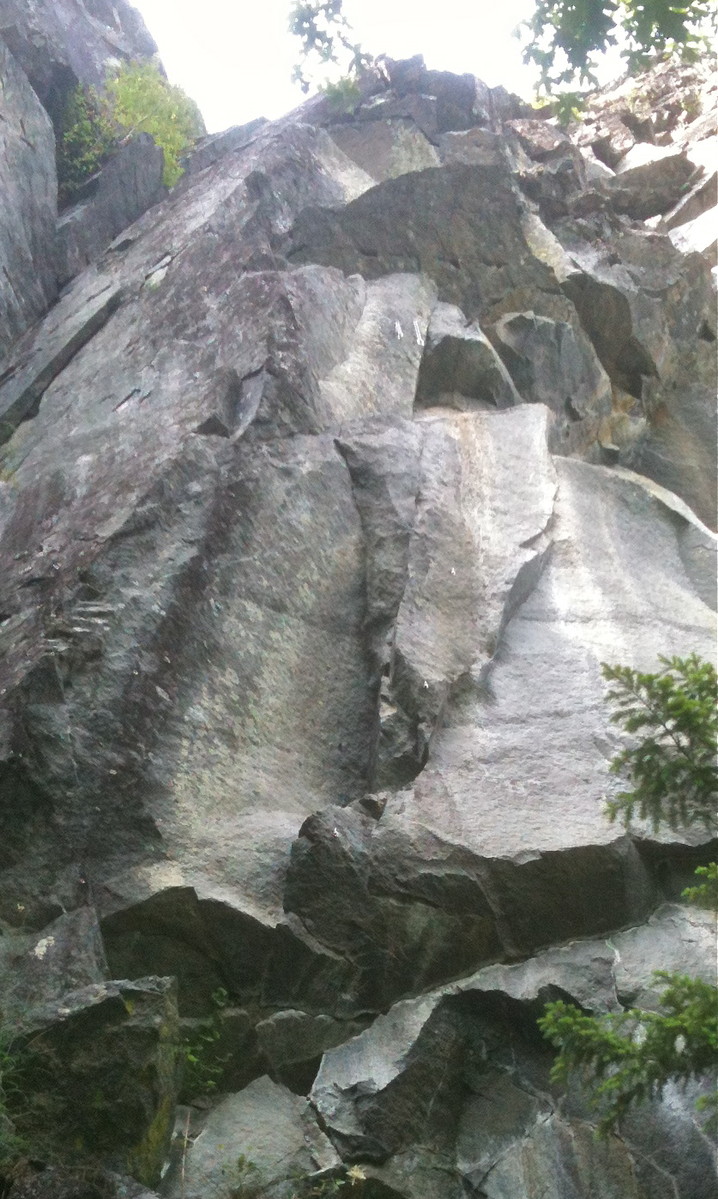
Duct tape engineering on Blade Runner
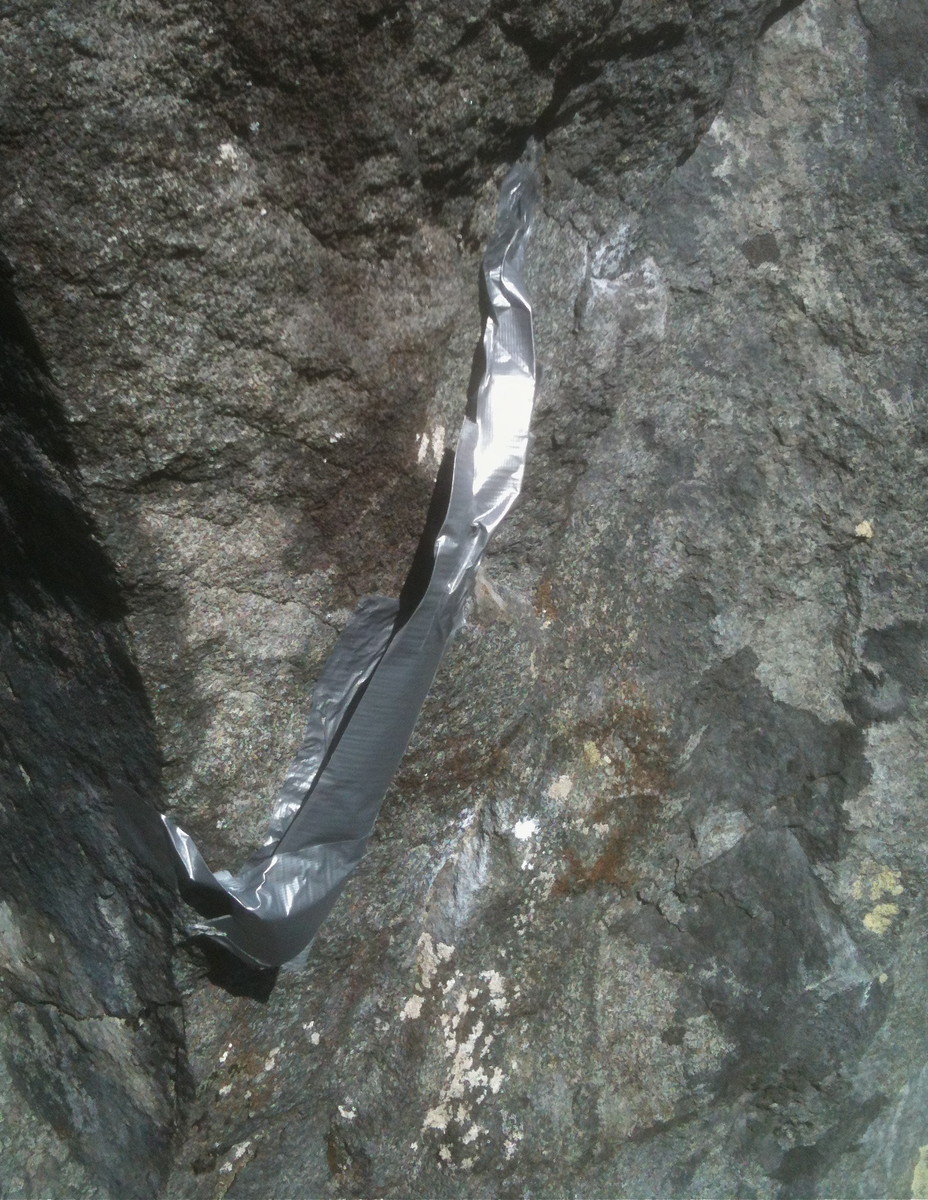
Skullduggery
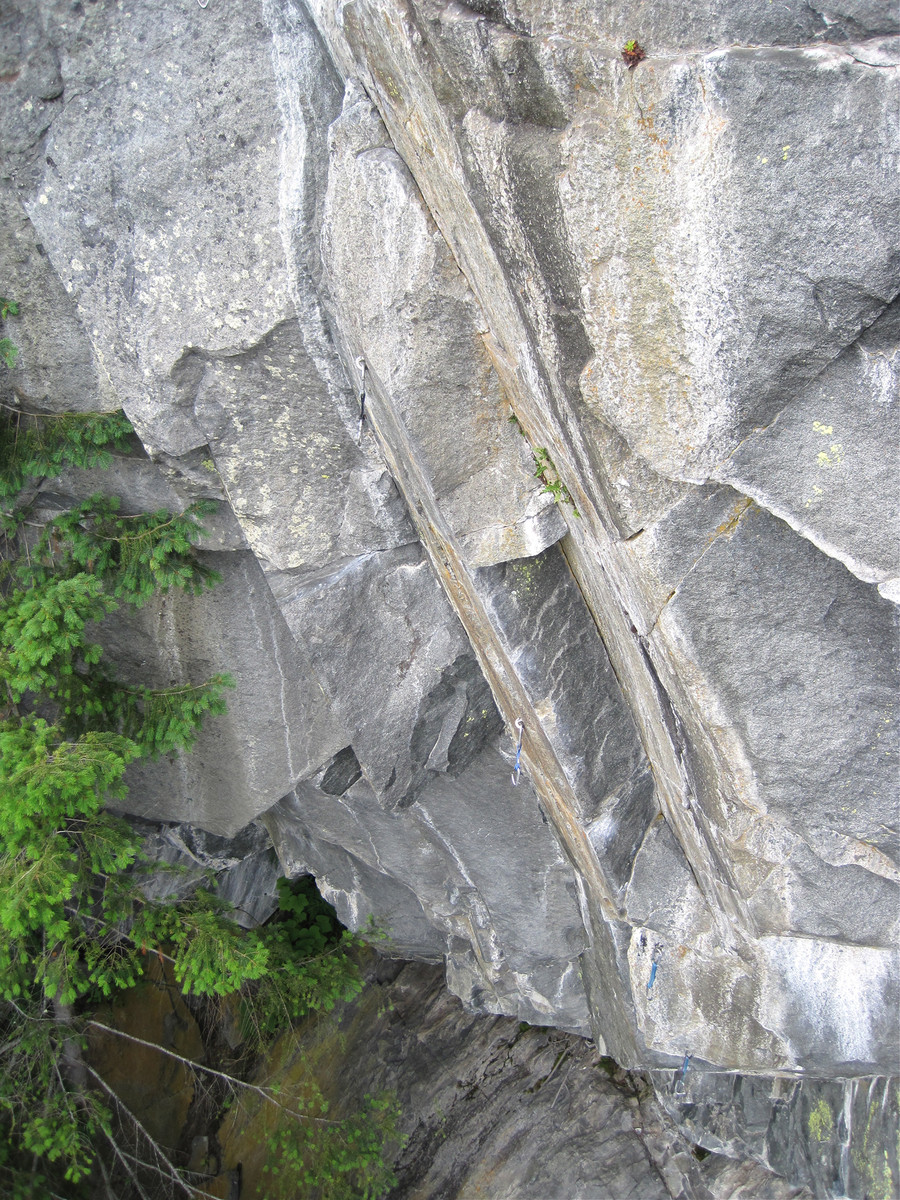
Skullduggery
Yellow is Metamorphosis. Red is Metaphysics.
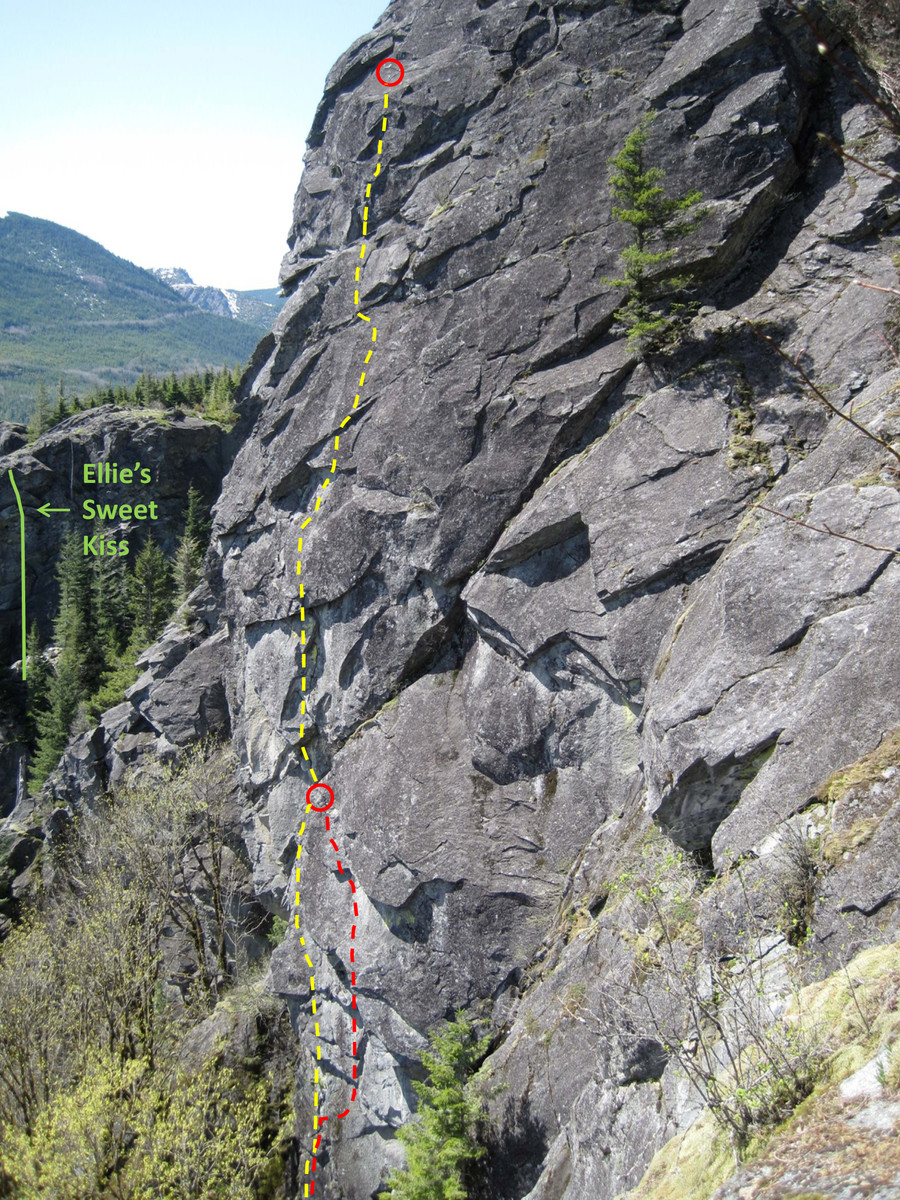
Metamorphosis is the yellow line. I'm approaching the top of Metaphysics. Both routes share a belay.
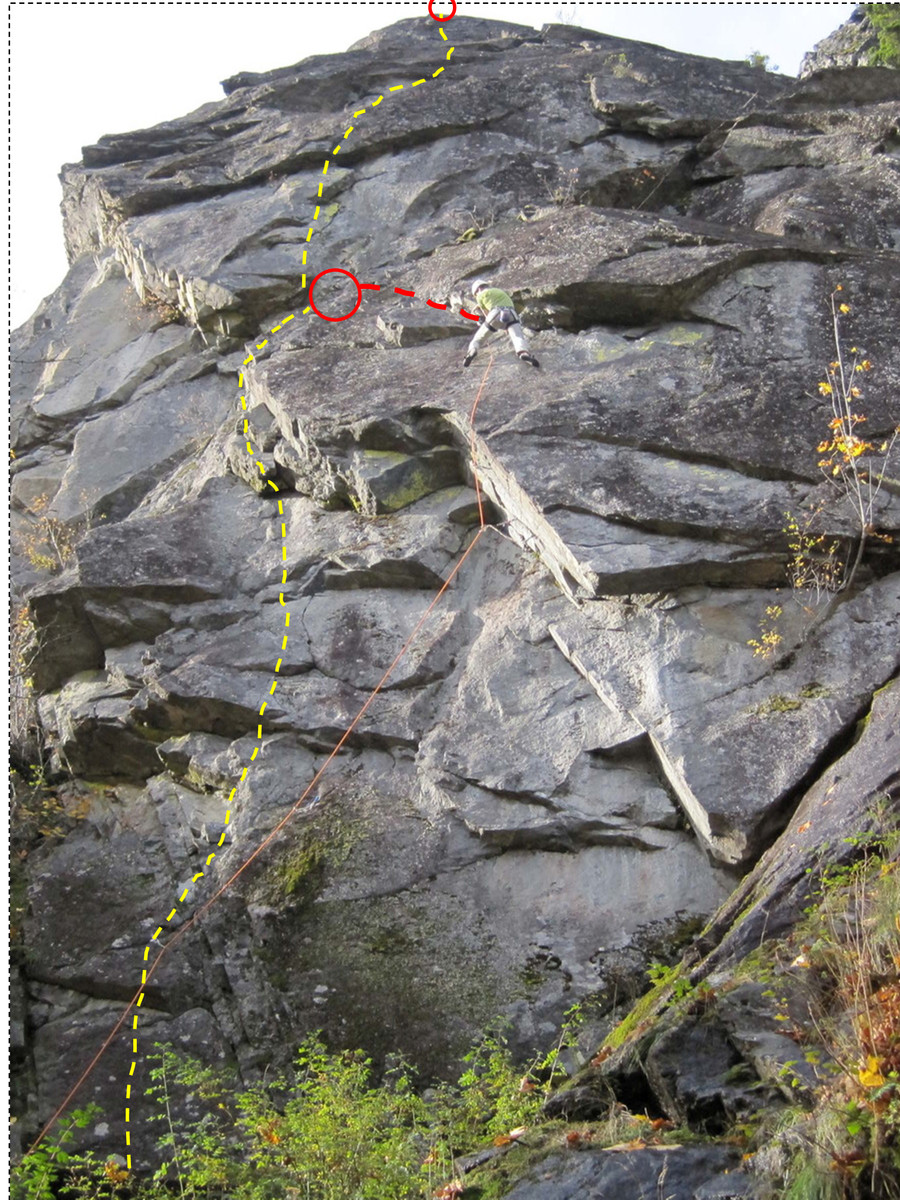
Metaphysics
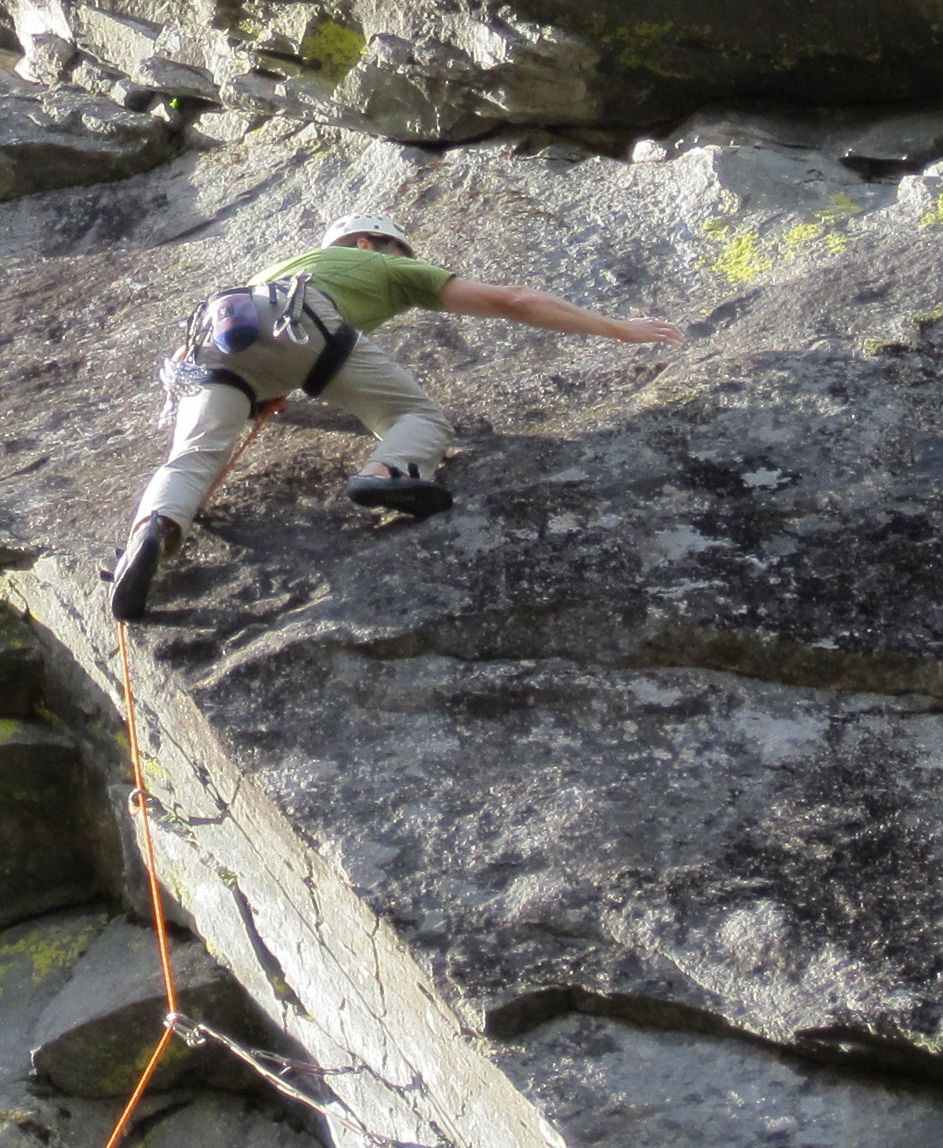
Metaphysics

Small Arms Fire
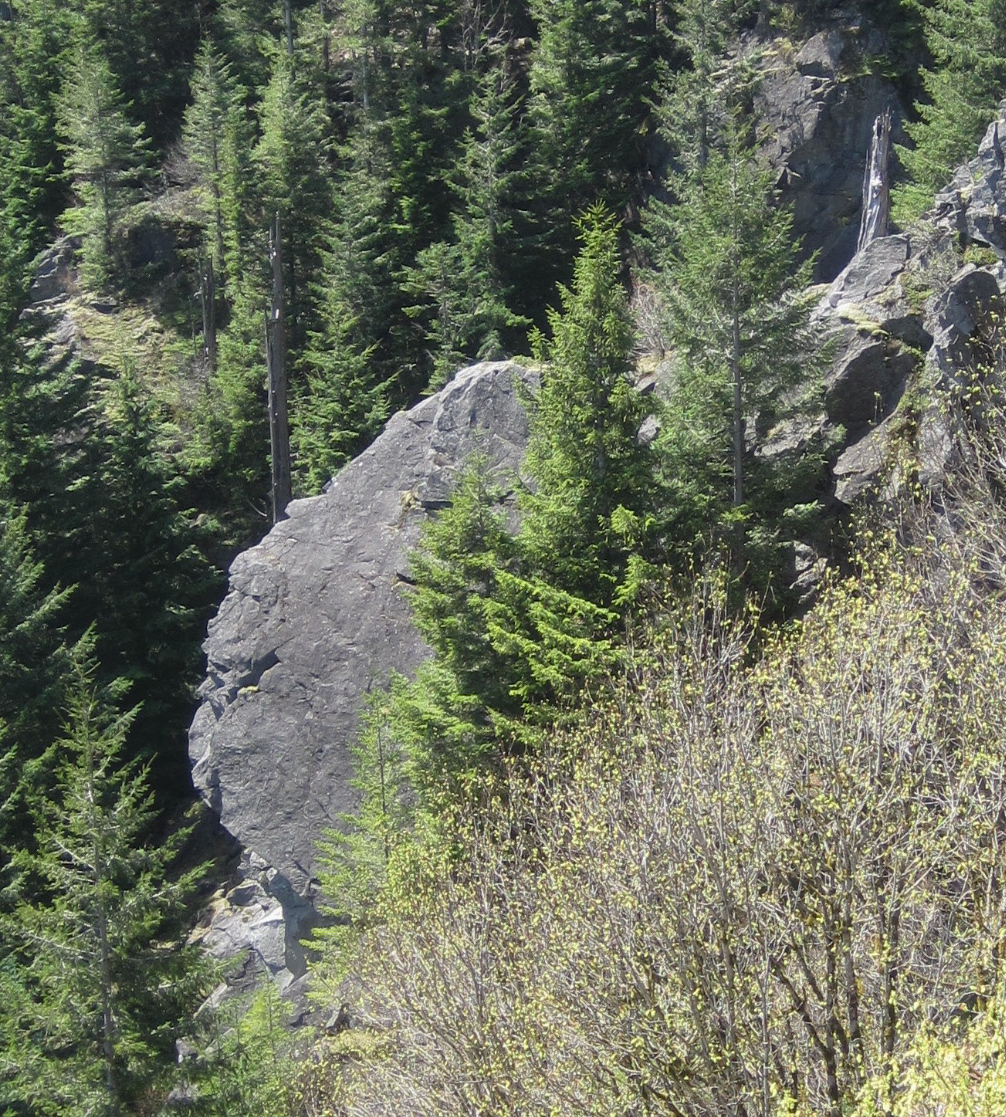
Gopro shot from the top of Small Arms Fire. The dead snag is 10 feet behind me.
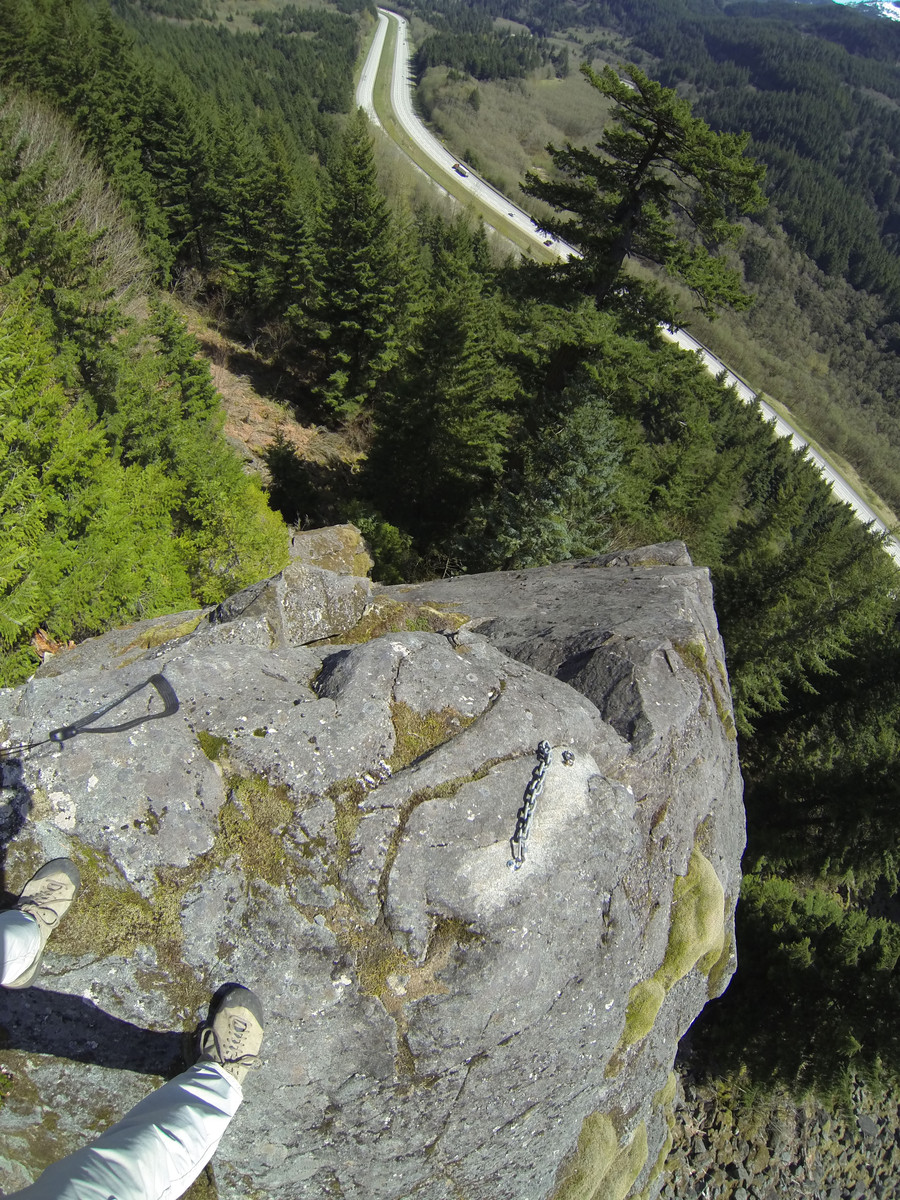
Third Stone from the Sun
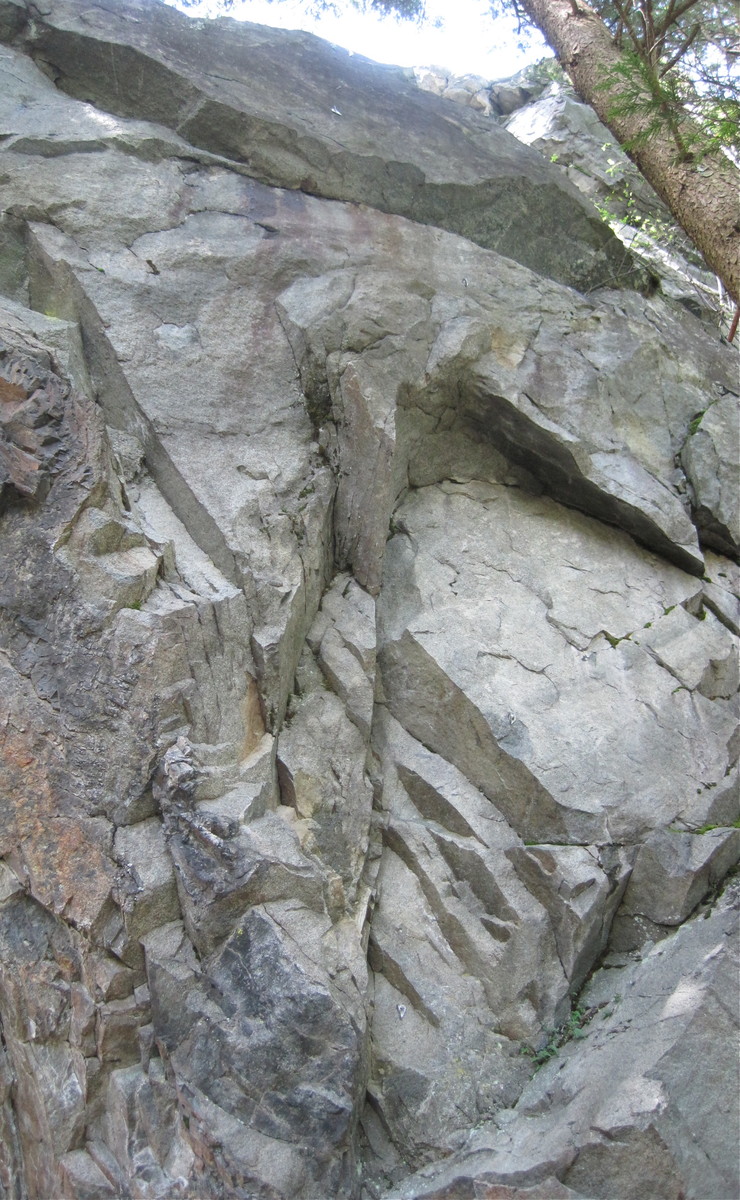
Don't forget to hit the swimming hole!
stay tuned for more...
THANKS TO MANY GREAT PARTNERS AND HELPERS OVER THE YEARS: Alex, Scott, Jens, Matt, David, Ed, Michael, Mike, Blake, Leland, Frank, Scott, Ryland, and others.
Gear Notes:
See route descriptions above.
Approach Notes:
X38 Far Side trails. See details and links above.
-
 1
1
-
-
I assume you mean the S face. This is essentially a walk up that doesn't require roping up. Snowboard boots might be fine. Perhaps you can get strap on crampons that will fit those boots. Alternatively, wear your mountaineering boots, which presumably can take crampons, and just board down in those.
Either way, bring an iceax for self arresting and
DON'T GLISSADE IN CRAMPONS! (You'll be boarding down anyway)
-
-
Though it may feel like spring down in the lowlands, you will probably encounter winter-like conditions at higher elevations. Watch the forecast and plan accordingly. Should be beautiful!
-
Good thing the whole cornice didn't come down with you.
-
Multipitch cleaning is a good way to learn about placements, assuming you're following a competent leader. Keep doing that.
-
Frankazoid took me up there. He can probably connect you w the developer. Send him and pm and if he doesn't respond send me a pm and I'll get him to contact you.
BTW, you should go check out Shangri-La at the Far Side this weekend if you can. It'll be sunny and dry and has a bunch of great routes, including two 12s on the overhanging face. The rock is far better than the cave you mention, though it does look cool. Pm me if you want beta on approach and routes. I've been meaning to put it on Mtn Project but haven't gotten around to it.
-
I'm moving back to PCs, so not likely to go w Mac based editing systems. Will look into the suggestion above. I do have the Adobe suite (through work). Does Adobe have video editing products that are good?
-
Bum #1 walks into a bar and asks for a toothpick. Bartender gives him one and the bum hurries out the door.
Bum #2 walks into a bar and asks for a toothpick. Bartender gives him one and the bum hurries out the door.
Bum #3 walks into a bar and asks for a straw. The Bartender says, "Don't you want a toothpick?" Bum#3: "Nope. Someone threw up in a parking lot, but all the good pieces are already gone, so I just need a straw."
-
The latest gopros seem to solve the aiming/review problem by offering wifi and an app that allows you to view the output on your smartphone. Seems like getting the top of the line Gopro version is the way to go so it won't be completed outdated in 6 months to a year.
All the reviews generally say it has the best image quality by far.
It would prob need to be hardwired transfer to the phone, or greatly compressed versions for viewing, otherwise you're moving a 75Mb file. I'll look into it. Thanks.
I've bought gopro3 silver and prob will return to go to black for various reasons, but if you look at comparison videos out there it's really hard to trust anything. What I hear is that 50-75% of product reviews are fakes, glowing reviews paid for by the vendor or thinly veiled rants from folks paid by competitors. That's why I posted here so you guys can tell me the real story. THx.
Also, I want a pole and the one at REI has a tendency to loosen, making me nervous the camera will pop off at a bad time such as on the lift.
Thx
-
Thanks. cc.com banners seem to be working because there's a gopro ad below!
-
Finally getting a POV camera for skiing/boarding, climbing, snorkeling, caving, and family fun. Wondering what hardware and software y'all recommend.
Priorities are image quality and performance, rugged, easy to use, and versatile.
Thx
Rad
-
... Cheating is about the lie, not the action. I....
perfecly said
Ditto.
I'll add that cheating implies competition, and I don't see alpine climbing that way at all. Not surprised that Twight does. His note reminds me of certain over the hill climbers who decry bolts used on 5.14 routes because back in the day, when climbers were real men, they climbed 5.10 on goldline.
 Now they lurk on the internet looking for bolting forums to dump their ideas.
Now they lurk on the internet looking for bolting forums to dump their ideas. 
Live and let live. Climb and let climb. sickie
Besides, Twight hasn't said anything new that Messner didn't say, and live by, decades ago.

-
Look at typical forecasts before you go. We were contemplating a family trip to Zion next summer and saw that July is the month with lots of thunderstorms and flash floods. You can have blue skies overhead, but if it rained in the mountains upstream you can be hosed, literally.
-
BACK on topic:
1 - A 15cm calf tear that kept me from running for 6 months.
2 - A $5000 medical bill for an ultrasound that confirmed said tear wasn't a deep venous thrombosis (fancy name for clot that can kill you). The bill should have been $150 so now I get to fight with health providers and insurance companies to straighten things out. It will probably be June, 2013 before the paperwork blizzard has cleared.
3 - Epic uphill, in the dark bushwhack from hell while lost in Cananuckistan. This caused us to change objectives but we still persevered to have an awesome adventure.
4 - Being psyched to climb with an old partner only to find he's two number grades stronger than me and does free-solo-warmups on my hardest routes. Ouch.
5 - Overloaded with two nearly full-time jobs during the best summer alpine rock weather window the Cascades has seen in a decade.
On the plus side, I found a new friend and climbing partner, stayed mostly injury-free outside the calf, and achieved the top 5 from the other thread.
-
This is not the droid you are looking for.To control Blackberry takes Apple with Samsung as backup.The Force INTERNET can have a strong influence on the weak-minded.
-
-
Work consumed more of my time last year than in years past, but I feel fortunate to have done the following top 5:
1 - FA of Blade Runner, a striking clean, overhanging face at Shangri-La at X38 with a devious bouldery crux. Without a doubt the hardest pitch I've ever climbed. Definitely worth repeating...
2 - NE Buttress of Slesse in perfect fall conditions.
3 - Roan Wall (Centerfold) and Salish peak (scrambling because we weren't fast enough getting to and up the Roan wall).
4 - FA of Science Friction at Shangri-La.
5 - A bunch of great powder days with kids, wife, friends, and by myself.
Extra 1 - This doesn't count in most people's books, and it really doesn't make my top 5, but I've definitely enjoyed climbing indoors regularly at SBP.
Extra 2 - I had a few work travel trips and got to visit climbing gyms in different places. Some are great (Planet Granite on the SF peninsula), some are OK (Rockville, Maryland), and some are atrocious (Vegas). Nonetheless, it's always interesting to sample new gyms and setters.
-
"Petraeus" sounds an awful lot like "betray us".
All In is now going to be a best seller where before few cared. We are a nation of rubberneckers who love to see the carnage of personal failures.
There are a slew of bad jokes about how God gave men a penis and a brain but not enough blood to operate both at the same time.
It's amusing when reality is more crazy and corny than the trashy fiction.
-
Sounds like a good project. Regarding Dallas, don't worry about paying him back for showing you cool crags. Pay it FORWARD to the next generation!
-
The real Pitch 1 of Center Stage.... sustained and beautiful and pretty close to a full 200ft.
You mean the first one on the main wall with the credit card edges? Loved that one! So much easier than some of the "10b" slab pitches at the end of the route, but maybe that's just me.
-
The biggest challenge of our time, perhaps of the century, is finding a way to meet the world's growing energy needs in a sustainable fashion. I find it shocking that reps are urgently worried about leaving our kids and grandkids with a lot of national debt, but they don't seem motivated to make sure we leave them a healthy and habitable planet.
Although he's not saying anything during the election, perhaps because swing states have seen gold and jobs in fracking and preservation of coal industry jobs, Obama understands the monumental energy challenge we face and is prepared to do what he can do deal with it. He invested billions into renewable energy research via ARRA, raised fuel efficiency standards to unprecedented levels, tightened emissions regulations on coal plants, fought against the tar sands pipeline from Canada, and provided loan guarantees and other incentives to renewable startups. He will do more if elected, likely via the EPA if the legislature is still an incompetent and constipated body paralyzed by its own poisonous rhetoric and short-term thinking. So I'll add an important #4 to Darin's list:
4 - Deal with the reality of climate change and the energy challenge.
Mitt would have us burn copious amounts of fossil fuels of all flavors and shut down all hope the US will lead the renewable energy revolution. Clean coal is an oxymoron.
-
From reports and photos of people here and elsewhere, I see climbers go out of their way to put protection in rock, perhaps because it is stronger, faster, and easier to place.



[TR] Canyonlands - Towers 5/1/2013
in The rest of the US and International.
Posted
Muy lindo. Me gustaria ir.